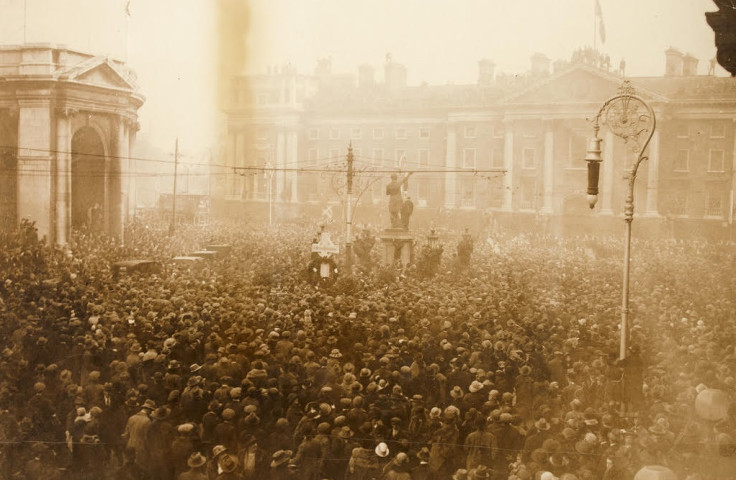Armistice day: Remembering Ireland's sacrifice
The First World War left a terrible legacy of suffering in Irish households.

Not since the great Home Rule rally of March 1912 had the streets of Dublin seen anything like it. The crowd assembled in College Green spread like tributaries of humanity into adjoining streets and lanes surrounding Dublin's great gathering point. It was the middle of November, yet extraordinarily mild.
Crowds clapped and cheered as ex-British servicemen marched in two directions to converge on College Green. One group left from, of all places, the General Post Office (GPO) – now rebuilt after its role as the birthplace of the Republic proclaimed in 1916. The other contingent came from Dame Street. The Union flag flew from Trinity College Dublin and from other buildings – though no longer the national flag.
The veterans marched proudly or limped. All wore their medals from the first World War. One old veteran wore his from the 1882 Nile campaign; others were just children wearing their father's medals.
Big crowds had turned out for a victory parade in Dublin in 1919, before independence. The crowds that descended on the centre of Dublin for Armistice Day 1924 took everyone by surprise, not least the Dublin Metropolitan Police (DMP) which had no traffic contingency plan in place. It anticipated a small crowd.
But a crowd estimated at 50,000 turned up on a normal working day. Many stayed until late that night. They had kept silent and their grief to themselves but, now seized of the opportunity to make a public display of their sorrow, they did not want to come home.
The war had left a terrible legacy of suffering in Irish households. AP Connolly – the head of the British Legion in Ireland – estimated that 165,000 Irish children had lost a parent, mostly a father, during the war period, 35,000 men had lost a leg or arm, 6,450 men had gone insane and were detained in "lunatic asylums" and 3,150 were suffering from epilepsy.
It was eight years after the Easter Rising. It was less than three years since the foundation of the Irish Free State. Yet here was nationalist Ireland paying tribute to the men who fought in British uniform during the first World War.
Many in nationalist Ireland were apt to remind those who had fought in British uniform of what had been achieved by fighting against and not for the British and previous Remembrance Day services had been the subject of clashes between republicans and unionists, but it was an altogether more sombre, subdued crowd on Armistice Day 1924.
The object that had prompted this national outpouring of grief and remembrance was a large Celtic cross, 13ft 6in high made of solid granite and weighing three tonnes. It was enclosed by a metal railing measuring 15sq ft. At its base was an inscription in Irish and English: "Do chum Gloire De agus Onora na hÉireann" (To the Glory of God and Honour of Ireland).
"In commemoration of the victories of Guillemont and Ginchy Sept 3rd and 9th 1916 in memory of those who fell therein and of all the Irishmen who gave their lives in the Great War RIP."
A wreath was laid by Senator Col Maurice Moore, formerly of the Connaught Rangers. It read, "O Rialtas Saorstát Éireann i gcuimhne na nÉireannach uile a fuair bás son choga mór (From the Government of Saorstat Éireann in memory of all the Irishmen who died in the Great War)".
One wreath came from Mary Kettle, the wife of Tom Kettle, who was killed at the Battle of Ginchy on September 9th, 1916.
It was the high watermark of Free State remembrance commemorations. In 1925, Republicans, angered by the Border Commission's decision to confirm the borders of the Free State, threw smoke bombs into the crowd. Within two years it was moved to the relatively peripheral Phoenix Park, though huge crowds still attended. The League of ex-Servicemen wanted to place a permanent Irish war memorial in Merrion Square, opposite Government Buildings but the Free State was vehemently against something so close to the seat of power.
The Minister for Justice Kevin O'Higgins, whose brother was killed in the war, was disposed to remembering Ireland's war dead, but not in Merrion Square. Such a prominent memorial suggested the new state was founded on the sacrifice of the men who died in the First World War 'and I have no desire to see it suggested that it is'
A beautiful if peripheral location was eventually found for the Irish National War Memorial in Islandbridge.
Extract from Wherever the Firing Line Extends: Ireland and the Western Front, published by The History Press. Available at amazon.co.uk. Ronan McGreevy is a journalist for the Irish Times
© Copyright IBTimes 2024. All rights reserved.







